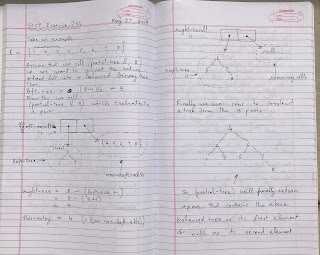SICP Exercise 2.64 list->tree
Exercise 2.64. The following procedure list->tree converts an ordered list to a balanced binary tree. The helper procedure partial-tree takes as arguments an integer n and list of at least n elements and constructs a balanced tree containing the first n elements of the list. The result returned by partial-tree is a pair (formed with cons) whose car is the constructed tree and whose cdr is the list of elements not included in the tree.
(define (list->tree elements)
(car (partial-tree elements (length elements))))
(define (partial-tree elts n)
(if (= n 0)
(cons '() elts)
(let ((left-size (quotient (- n 1) 2)))
(let ((left-result (partial-tree elts left-size)))
(let ((left-tree (car left-result))
(non-left-elts (cdr left-result))
(right-size (- n (+ left-size 1))))
(let ((this-entry (car non-left-elts))
(right-result (partial-tree (cdr non-left-elts)
right-size)))
(let ((right-tree (car right-result))
(remaining-elts (cdr right-result)))
(cons (make-tree this-entry left-tree right-tree)
remaining-elts))))))))
a. Write a short paragraph explaining as clearly as you can how partial-tree works. Draw the tree produced by list->tree for the list (1 3 5 7 9 11).
b. What is the order of growth in the number of steps required by list->tree to convert a list of n elements?
SOLUTION
The code and tests are here.
(define (list->tree elements)
(car (partial-tree elements (length elements))))
(define (partial-tree elts n)
(if (= n 0)
(cons '() elts)
(let ((left-size (quotient (- n 1) 2)))
(let ((left-result (partial-tree elts left-size)))
(let ((left-tree (car left-result))
(non-left-elts (cdr left-result))
(right-size (- n (+ left-size 1))))
(let ((this-entry (car non-left-elts))
(right-result (partial-tree (cdr non-left-elts)
right-size)))
(let ((right-tree (car right-result))
(remaining-elts (cdr right-result)))
(cons (make-tree this-entry left-tree right-tree)
remaining-elts))))))))
a. Write a short paragraph explaining as clearly as you can how partial-tree works. Draw the tree produced by list->tree for the list (1 3 5 7 9 11).
b. What is the order of growth in the number of steps required by list->tree to convert a list of n elements?
SOLUTION
The code and tests are here.
The graph above also indicates a linear order of growth O(n)




Comments
Post a Comment